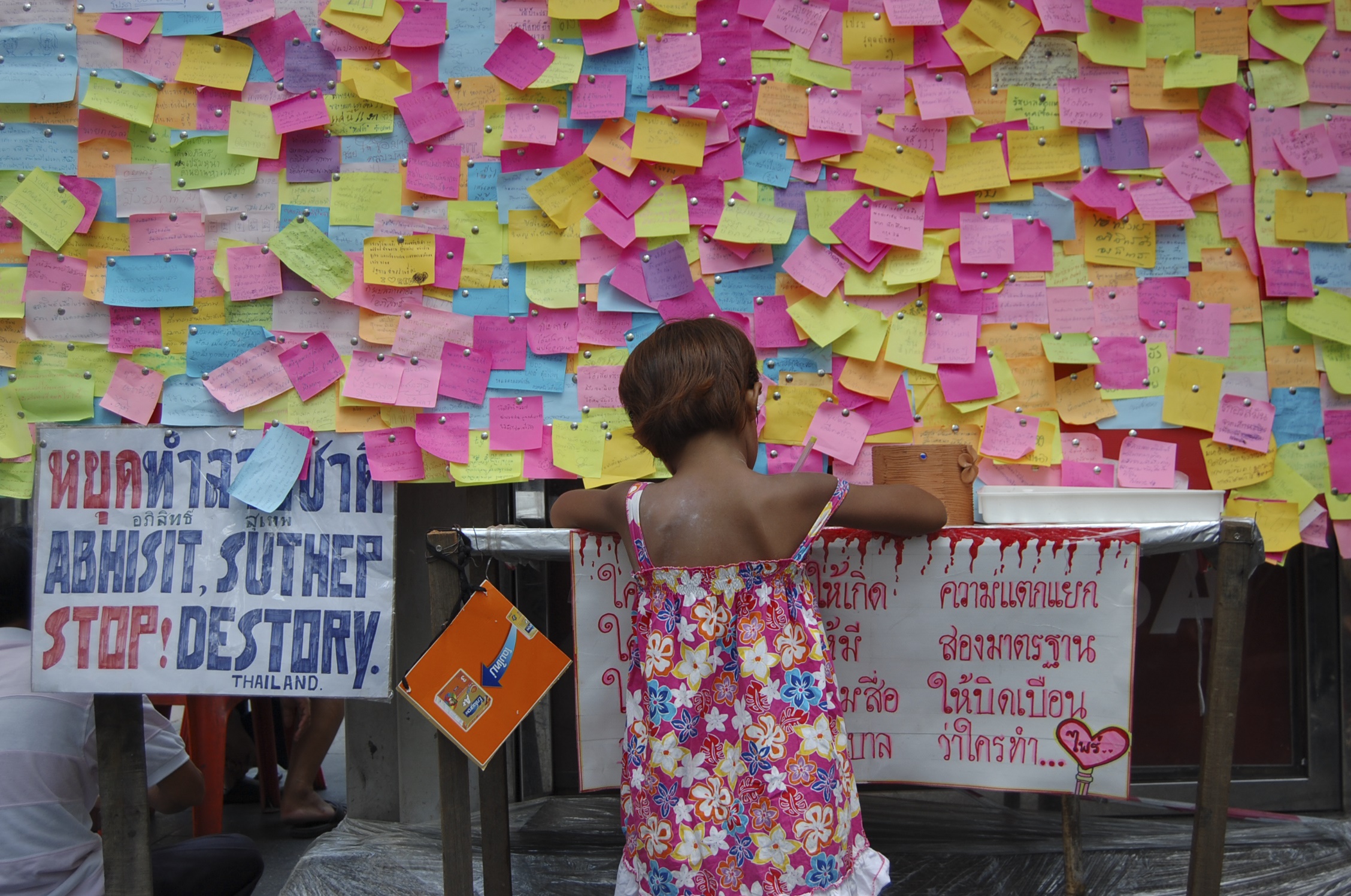Ratchaprasong Notes (Say Hi to the Leaders)
I first saw the ‘Say Hi to the Leaders’ signboard during one of my visits to the Rachaprasong protest site in Bangkok, Thailand in April-May 2010. My first and immediate thought was that someone should preserve this. A unique collection of handwritten post-it notes pinned on big plastic sheets made into a signboard, standing on the corner of Rachaprasong in front of the Gaysorn shopping mall. Post-its full with messages to the Red Shirt leaders.
The next time I saw the signboard was during a television broadcast on 19 May, the day the Thai army shot down the protest and overran the protest-site with armoured vehicles. This time, the signboard was standing just of Ratchaprasong intersection on Ratchadamri Road. These protests were organised by the United Front for Democracy Against Dictatorship (UDD, also known as "Red Shirts") in Bangkok, Thailand from 12 March until 19 May 2010 against the Democrat Party-led government. The UDD called for Prime Minister Abhisit Vejjajiva to dissolve the parliament and advance the elections. The protests escalated into prolonged violent confrontations between the protesters and the military, and attempts to negotiate a ceasefire failed. More than 80 civilians and six soldiers were killed, and more than 2,100 were injured by the time the military violently ended the protest.
Together with a friend, I went there the next day to see if I could salvage the board and the post-it notes that were pinned on it. Arriving at the scene I was surprised to find the board still in one piece and back on its old place in front of Gaysorn. A few meters away from the board stood a few fully armed soldiers, but my intuition told me that we probably did not had to fear them. They likely had specific instructions on when to act and a strange behaving farang (foreigner) would not be one of reasons. With some tools my friend and I started to dismantle the board, including a signboard with images from the shootings at the Khok Wua intersection on 10 April. The soldiers looked a bit surprised but didn’t react.
When we started walking, a man who looked like an officer called us and pointed to the signboard I was carrying. I told my friend to walk on and ignore the soldier. I walked up to officer, who then explained he did not only want the signboard with photographs, but everything I had with me. I gave him only that particular signboard, but kept the board with post-its, ignored him and walked on. In reaction (apparently, he had to stay put on his position) he started to shout to the soldiers at a roadblock further down the street, but they didn’t understand what his problem was and thus let us pass. Another 4 or 5 roadblocks were as easily taken. We decided to drop off the board at a friend’s apartment not too far away. It was so heartwarming to see how excited the street vendors and the cleaners of the friend’s apartment building reacted when they realized what we were carrying.
In the end the 1099 post-it notes that came of the board made their way to the IISH in Amsterdam. Our staff translated and scanned the material, made an inventory with images, translations and the original text in Thai (telephone numbers have been removed for privacy reasons).
For sure there must have been many more messages, as the board was standing there for at least 2-3 weeks from the first time our observer noticed it. Unfortunately we haven’t been able to do background research on this initiative, whose idea it was, how long the board was there, whether the messages actually reached the “leaders” (the hierarchical distinction that was made between the “leaders” and the “common” Thai people is a bit contradicting in this case), whether earlier notes have been taken away and were kept somewhere, or whether the 1099 post-its (plus those who were lost during the transport by foot) were all there were.
The messages are moving, emotional, damning, scolding, hopeful, sexually explicit, funny. Some of them are homophobic (mostly when Prem Tinsunalond is targeted, head of the privy-council at the time and accused of being a master-schemer), some contain Lèse Majesté content (paragraph 112, the Royal Defamation Law, with heavy punishments). Above all, the messages are sincere. In short it is beautiful primary source material from the heart of a protest movement. A protest movement that found its way in many forms to the IISH collection.
Eef Vermeij
Further info:
Say Hi to the Leaders Collection
The original banner on top of the board:
If you want to know more about the protests and the military crackdown read in Thai: Khwam jring pue khwam yutitham : hedkan lae polkratob jak kan salai kan chumnum mesa prusapha ha sam by Chaithawat Tulathon. The English version you can find here.



